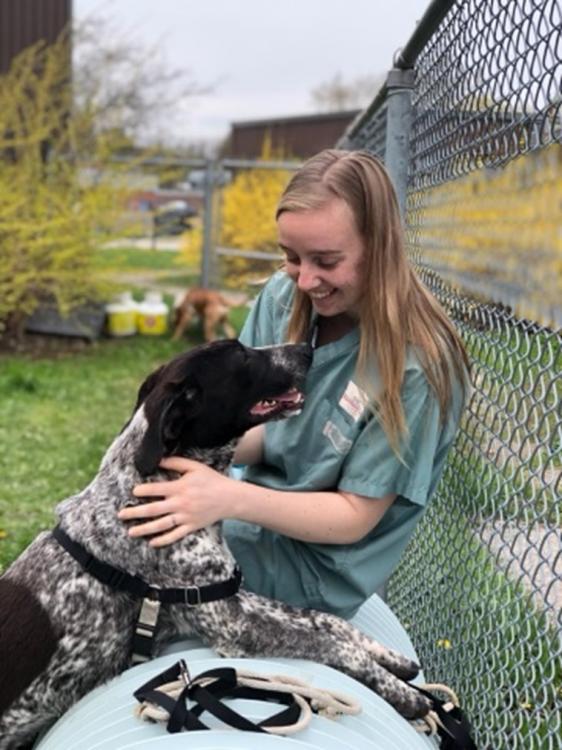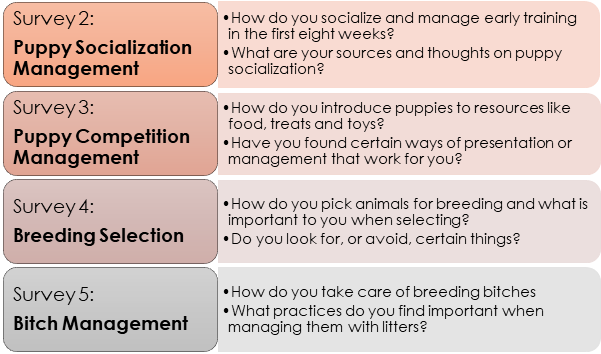Guest Blogger, Quinn Rausch : The Puppy Project!
As part of IPFD's support of new research and research participation, we welcome this guest blog by Quinn Rausch. The Puppy Project is an opportunity for breeders in the US and CA to contribute to important research on puppy socialization and behaviour development. The content of this blog, including external links and all information was provided by Quinn Rausch, and all questions should be directed to them.
Background to the Puppy Project
To what extent does a young puppy’s experiences affect their behaviour later in life? Every year thousands of puppies are purchased in Canada and the United States and yet little is known about the rearing environments of these dogs or attitudes of breeders around common breeding practices (ref. 1). Previous research from other countries suggests that breeding practices and attitudes can vary greatly (ref. 1-4). Early experiences are known to impact adult temperament (e.g., fear and aggression) and to influence the development of undesirable behaviours (ref. 5-7). Experiences during this period appear to be more influential than any other period (ref. 6-9). A puppy’s first critical period for learning and socialization begins at 3 weeks of age when senses and motor skills become more developed and extends to approximately 14 weeks of age (ref. 5). Broad exposure to a range of different stimuli during this period is thought to be necessary for normal behavioural development. However, it is not clear how much exposure to particular stimuli is sufficient to prevent fear-related issues, and whether early experiences prior to purchase can be protective against inadequate socialization in the new home.
Competitive behaviours are also observed in puppies as early as 3 weeks, and some have suggested that early competition might reflect general tendencies that can lead to resource guarding behaviours later in life. Again, the role of early experiences prior to sale have not been fully explored. The majority of studies examining fear and aggression in dogs are based on data collected retrospectively from primary owners of adult dogs and information before purchase at 8-9 weeks of age is not available (ref. 10-14). These early experiences and management practices (0-8 weeks of age) may increase or decrease the likelihood of an undesirable behaviour developing and are important to consider. There are a number of factors that might be influential during this period, including maternal behaviour, food and resource management, and early socialization experiences but they have not been thoroughly studied.
Meet the researcher
My name is Quinn Rausch (they/them pronouns) and I am a PhD Candidate in the OVC Companion Animal Behaviour and Welfare Lab under the guidance of Dr. Lee Niel. I have always been fascinated by the relationship we have with non-human animals that share our planet and are ingrained in our society with diverse roles such as companions, entertainment, food, workers, lifelines, etc. I developed my interest in animal behaviour and welfare research early in my undergraduate degree in animal biology through volunteering and spending my summers doing research fulltime. Outside of my research, I am interested in military and service dog training and hope to meld my military career with my academic one to promote the welfare of these invaluable members of our society.
Join the Puppy Project
A part of my PhD research examines how breeding dogs and puppies are managed in Canada and the United States with a series of five surveys for dog breeders.
These surveys will:
- determine which puppy and bitch management practices are common within the breeding community
- determine whether there are demographic variables that are associated with certain practices (e.g., breed club or community membership).
In future research I will also explore whether particular management practices are protective against development of fear, competition and related undesirable behaviours. In other words, I want to know what works to encourage healthy behavioural development in dogs!
 The first survey about puppy management is now open for participation. This survey focuses on how breeders care for and manage puppy environments from birth onwards, as well as breeder requirements around puppy sales (e.g., owner screening, puppy health checks). If your dog has had a litter of puppies in the last two years (whether you are a breeder or not) and you live in Canada or the United States, you are eligible to participate. Each participant in each survey will have the opportunity to enter a prize draw to win a $100 Amazon gift card as a token of our gratitude for participation.
The first survey about puppy management is now open for participation. This survey focuses on how breeders care for and manage puppy environments from birth onwards, as well as breeder requirements around puppy sales (e.g., owner screening, puppy health checks). If your dog has had a litter of puppies in the last two years (whether you are a breeder or not) and you live in Canada or the United States, you are eligible to participate. Each participant in each survey will have the opportunity to enter a prize draw to win a $100 Amazon gift card as a token of our gratitude for participation.
Overall, the results of these studies will allow us to understand how to best manage, train and socialize puppies while they are still with the breeder, and once they are in the home. My aim is to work collaboratively with breeders to improve canine breeding programs and canine welfare. Results of these studies will be published in academic journals and shared on our website and social media. Updates can be found on our lab website or our Facebook Page as well as other research projects, opportunities, and recruitment:
Website
https://niel-lab.uoguelph.ca/sample-page/participant-recruitment/the-puppy-project/
Facebook
https://www.facebook.com/OVC-Companion-Animal-Behaviour-and-Welfare-Lab-942402815800631
If you have any questions about this research, please feel free to get in touch with me directly by email at companion.welfare@uoguelph.ca
Survey Series
Survey 1: Puppy Management
Participate here! Link to Survey 1: https://uoguel.ph/puppysurvey1general

Over the next six months I will be releasing the remaining four surveys including:

References
1. Dendoncker, P., De Keuster, T., Diederich, C., Dewulf, J., Moons, C. On the origin of puppies: Breeding and selling procedures relevant for canine behavioural development. Vet. Record. 2019, 284, 710.
2. Worboys, M., Strange, J., Pemberton, N. 2018. The Invention of the Modern Dog: Breed and Blood in Victorian Britain. Johns Hopkins University Press.
3. McMillan, F. 2017. Behavioral and psychological outcomes for dogs sold as puppies through pet stores and/or born in commercial breeding establishments: current knowledge and putative causes. J. Vet. Behav. Clin. Appl. Res. 19: 14-26.
4. Nagasawa, M., Mitsui, S., En, S., Ohtani, N., Ohta, M., Sakuma, Y., Onaka, T., Mogi, K.., Kikusui, T. 2015. Oxytocin-gaze positive loop and the coevolution of human-dog bonds. Science 348: 333-336.
5. Scott, J.P. & Fuller, J.L. 1965. Genetics and the social behavior of the dog. University of Chicago Press, Chicago, IL.
6. Howell, T., King, T., Bennett, P. Puppy parties and beyond: The role of early age socialization practices on adult dog behavior. Vet. Med. Res. Rep. 2015, 6, 143
7. Scott, J. Marston, M. 1950. Critical periods affecting the development of normal and mal-adjustive social behavior of puppies. Pedagogic. Semin. J. Gen. Psychol. 77: 25-60.
8. Scott, J. 1957. Critical periods in the development of social behaviour in puppies. Psychosomatic Medicine. 20: 42-54.
9. Fox, M., Stelzner, D. 1966. Behavioural effects of differential early experience in the dog. Anim. Behav. 14: 273-281.
10. Guy, N., Luescher, A., Dohoo, S. 2001. Demographic and aggressive characteristics of dogs in a general veterinary caseload. Appl. Anim. Behav. Sci. 74: 15-28.
11. Haug, L. 2008. Canine aggression towards unfamiliar people and dogs. Vet. Clin. Small Anim. 38: 1023-1041.
12. Hsu, Y., Sun, L. 2010. Factors associated with aggressive responses in pet dogs. Appl. Anim. Behav. Sci. 123: 108-1041.
13. Blackwell, E.J., Twells, C., Seawright, A., Casey, R. 2008. The relationship between training methods and the occurrence of behaviour problems as reported by owners in a population of domestic dogs. J. Vet. Behav. 3: 207-217.
14. Tiira, K. Lohi, H. 2015. Early life experiences and exercise associate with canine anxieties. PLoS ONE 10: e0141907.
 Donate
Donate

0 Comments
Recommended Comments
There are no comments to display.